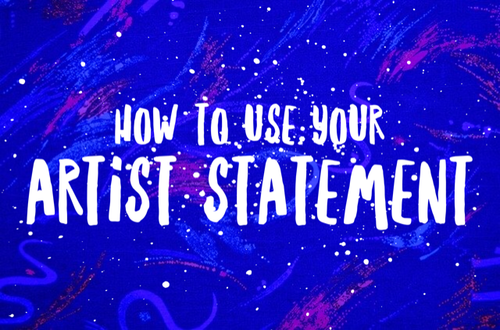by Carolyn Edlund
An artist statement is an important part of the materials you present about your art and yourself to the world. Here are ways to use it effectively.

Art presents visually to be appreciated and interpreted by the viewer. The art itself is the fruit of your creative spirit, the product of your imagination and expertise. But the art itself needn’t stand alone; the artist can offer supporting materials that add insight and enhance the experience. These include the title of the piece, description of the work, and what the artist has to say about their work, often in the form of an artist statement.
The artist statement looks inward. It answers questions like:
- How do you describe your overall vision?
- What intrigues and inspires you as an artist?
- How do you bring that inspiration to life?
- What is your process?
- Which techniques do you use, and what steps do you take?
- What do you wish to convey to others through your art?
The artist statement can be contrasted with a brand story (or brand narrative) which looks outward. This type of content reaches out to the reader and tells them why your art matters in the world, why they should care, why they should want to own the art. They can work perfectly together to tell the artist story while making it part of the reader’s story as well. Artist statements are also commonly used with collateral such as the artist CV, testimonials from collectors, and an artist bio. Together, they serve to spark and grow a relationship between the artist and their audience.
Use your artist statement in different ways:
- Include it in submissions. These may be competitions for online or in-person exhibitions, art fairs, grant applications, or proposals.
- Make your artist statement a key part of your presentation when approaching galleries for representation.
- Incorporate your statement in applications to schools as a student, or as an instructor.
- Place your artist statement in full or in part within your marketing collateral, and use it in catalogs and brochures.
- Your artist statement should be considered an important element of your artist website. Many artists devote a specific page to their statement, but it may appear on your About page or shown next to artwork itself.
- Include parts of your statement in the script for a video about your work. Embed videos on your website, share them on social media, and post them on YouTube or Vimeo where they can be found through search.
- Use your artist statement in the messaging you create for press releases or to place in a media kit.
- Have an opportunity to speak about your art? Draw from your artist statement to create content for an artist lecture or a talk at an exhibition or elsewhere, to enlighten the audience about your work and purpose.
Reusing your artist statement in whole or in part across channels keeps your message consistent and cohesive. Every contact you have with the public, with potential collectors, galleries or other professionals requires thoughtful content. Creating content isn’t easy! A well-written artist statement is a foundational part of your presentation to the world, and it should be referred again and again.
Your artist statement will evolve over time, as your work grows and changes. Take a look at your statement on a yearly basis to determine whether it expresses what you need to say about your current work, and make adjustments.



Speak Your Mind